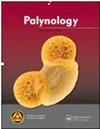Contribution to pollen morphology of Astragalus L. section Aegacantha Bunge (Galegeae, Fabaceae) and its systematic significance
IF 1.3
4区 地球科学
Q3 PALEONTOLOGY
引用次数: 0
Abstract
ABSTRACTAstragalus L. sect. Aegacantha Bunge has 57 described species mostly confined in Southwest Asia and Central Asia. Here, we studied the pollen morphology of 17 species from this section present in Pakistan. Pollen morphology of sect. Aegacantha species is poorly investigated despite its systematic importance. The main aim of this study is to determine and document the pollen characters that can help in the taxonomic identification of species in this difficult section. Pollen slides were prepared following acetolysis and examined by both light and scanning electron microscopy. Pollen size varies, with the polar axis ranging from 32.91-43.10 μm and the equatorial axis from 22.91-28.47 μm. The shape of pollen is sub-prolate (1.15-1.33) to prolate (1.34-2.00), small to medium in size, radially symmetrical, isopolar, trizonocolporate to tricolporate and monads. Sculpturing variations (i.e. reticulate, microreticulate, perforate, microperforate, regulate, microregulate and granulate) were observed around the apertural, meridional and polar regions. Ordination (PCA) analysis revealed that the quantitative characters of pollen morphology are the most reliable characters for delimitation of section Aegacantha species. Cluster (UPGMA) analysis shows a partial relationship between the Aegacantha taxa clustered based on pollen characters and supports the general morphology. Further, this study shows that the pollen traits provide a baseline for phylogenetic optimization in the investigated Aegacantha section.KEYWORDS: TaxonomypalynologyphylogenySEM-analysisPCAUPGMAPakistanDisclaimerAs a service to authors and researchers we are providing this version of an accepted manuscript (AM). Copyediting, typesetting, and review of the resulting proofs will be undertaken on this manuscript before final publication of the Version of Record (VoR). During production and pre-press, errors may be discovered which could affect the content, and all legal disclaimers that apply to the journal relate to these versions also.黄芪(gaacantha Bunge)剖面花粉形态的贡献及其系统意义
摘要/ abstract摘要:加棘属(Aegacantha Bunge)有57种,主要分布在西南亚和中亚。本文对分布于巴基斯坦的17种植物的花粉形态进行了研究。尽管其在系统上具有重要意义,但其花粉形态的研究却很少。本研究的主要目的是确定和记录花粉特征,以帮助在这一困难的剖面中进行物种分类鉴定。乙酰解后制备花粉载玻片,用光镜和扫描电镜观察。花粉的极轴在32.91 ~ 43.10 μm之间,赤道轴在22.91 ~ 28.47 μm之间。花粉的形状为近长形(1.15-1.33)至长形(1.34-2.00),大小小至中等,径向对称,等极性,三聚体至三聚体和单胞体。在孔洞区、子午区和极区周围观察到雕刻变化(即网状、微网状、穿孔、微穿孔、调节、微调节和颗粒状)。排序(PCA)分析结果表明,花粉形态的数量特征是最可靠的物种划分特征。聚类分析(UPGMA)表明,依花粉特征聚类的Aegacantha类群具有一定的相关性,支持其一般形态。此外,本研究表明,花粉性状为所调查的Aegacantha区段的系统发育优化提供了基线。作为对作者和研究人员的服务,我们提供此版本的已接受稿件(AM)。在最终出版版本记录(VoR)之前,将对该手稿进行编辑、排版和审查。在制作和印前,可能会发现可能影响内容的错误,所有适用于期刊的法律免责声明也与这些版本有关。
本文章由计算机程序翻译,如有差异,请以英文原文为准。
求助全文
约1分钟内获得全文
求助全文
来源期刊

Palynology
地学-古生物学
CiteScore
3.40
自引率
26.70%
发文量
48
审稿时长
>12 weeks
期刊介绍:
Palynology is an international journal, and covers all aspects of the science. We accept papers on both pre-Quaternary and Quaternary palynology and palaeobotany. Contributions on novel uses of palynology, review articles, book reviews, taxonomic studies and papers on methodology are all actively encouraged.
 求助内容:
求助内容: 应助结果提醒方式:
应助结果提醒方式:


